A Budget Home Theater & PC Setup: 4K, HDR, UHD Blu-ray, and More
by Ganesh T S on December 26, 2017 8:30 AM ESTLocal Media Playback
Our typical HTPC testing flow involves playing back files encompassing a range of relevant codecs, containers, resolutions, and frame rates. A note of the efficiency is also made by tracking GPU usage and power consumption of the system at the wall. Over the last year or two, the focus has been on using Kodi and MPC-HC with its built-in LAV filters for benchmarking. Even though we have had non-HDR 4K clips for some time now in our test suite, we have not subject them playback at native resolution. In order to augment our test suite, we have added two files, a 4Kp25 HEVC HDR stream in a MKV container, and a 4Kp60 VP9 Profile 2 HDR stream in a WebM container.
Out of all the options we evaluated, the TCL 55P607's in-built Roku platform is the only one capable of handling Dolby Vision videos. However, when we tried to play back a sample file, the Roku interface stalled in the retrieving stage after the appearance of the Dolby Vision logo.
The TCL 55P607 Roku Media Player App - Unable to Handle Local Dolby Vision Files
Due to the absence of reliable open-source editing and decoding tools for Dolby Vision in the PC space, its testing with local media files will have to wait.
The Roku Media Player app continues to be a disappointment for users with anything other than the standard H.264 / HEVC-based camcorder files. The following recorded clip shows its failure with some interlaced MPEG-2 and H.264 clips in TS containers. VC-1 is also not supported.
On the plus side, we have automatic switching to HDR for local files which have HEVC HDR content. On the othr hand, a VP9 Profile 2 HDR clip did not generate the mode switch.
We tracked the power consumption of the TV while the Roku interface tried playing back the various files in our test suite. It was not much of a surprise to find that Roku fails to play back many of the streams. The graph segments below corresponding to the files that didn't play back are just the display remaining idle in the Roku USB Player interface.
The NVIDIA SATV supports all files in our test suite except the one encoded in VP9 Profile 2. With Kodi, we even see the HEVC HDR file being decoded and sent to the display with the appropriate mode switch.
The NVIDIA SHIELD Android TV Supports HDR Playback with Local Files
The power consumption of the SATV was tracked during the playback of each file in our test suite using Kodi 17.6. The segment corresponding to the VP9 Profile 2 file is just the duration for which the audio track was decoded and the Kodi UI remained idle.
Moving on to the PC space, we first compare the DXVAChecker outputs for the three systems. The Zotac EN1080K with its GTX 1080 GPU does not support hardware decoding of VP9 Profile 2 videos. Even if a HDR stream were to be available, the system plays back only the non-HDR versions with the desktop in HDR mode.
The Absence of VP9 10-bit Profile 2 Decoding in the GTX 1080 is the Only Odd Spot (from L to R: ASRock Beebox-S 7200U, Zotac ZBOX MAGNUS EN1080K, and the Intel NUC7i7BNHX1)
We found the native Microsoft Movies & TV app to be capable of playing back HDR videos with the desktop in HDR mode. A comparison of playback using two different players in that mode is shown below.
However, the playback of HDR files in non-HDR mode using the Microsoft Movies & TV App results in messed up colors. As such, we don't recommend the Movies & TV app for HDR file playback under all circumstances.
It is possible to use the madVR renderer in conjunction with a suitable player to shift the display to HDR mode independent of the OS setting. It is also supposed to bring the display back to the original state when exiting. We tested it out with MPC-HC and madVR v0.92.10 on the Zotac EN1080K. On the KBL-U systems, using madVR as the renderer resulted in evident dropped frames irrespective of the setting. On the Zotac EN1080K, we found that the latest NVIDIA driver release (which we absolutely had to use for Netflix 4K playback) seemed to have some issues with the restoration of the previous mode. With certain settings, the colors seemed to get crushed significantly after madVR triggered the mode change.
In fact, the only reliable combination in which we could get playback of the files in the appropriate mode was to set the OS toggle for HDR, and allow madVR to pass through the HDR metadata directly to the display (something that the madVR author specifically mentions as unsuitable for purists). We do not have automatic mode switching or even identification of HDR when using Kodi (as of v17.6). With madVR and MPC-HC, it is possible, but the consumer experience may vary.
In our opinion, HDR local media playback is yet to reach a stable state with commonly used software combinations. CyberLink's PowerDVD 17 also supports automatic HDR mode switch for playback of local files on Intel GPU-based systems. We found that it worked well in both of the KBL-U PCs, but, PowerDVD unfortunately refused to play back the VP9 Profile 2 files on those systems.
The power consumption of the three PCs during the playback of each file in our test suite using Kodi 17.6 was recorded. The same was done using the Microsoft Movies & TV app also, but, we found significant power consumption change (up to 10W at the wall) when the control overlay appeared on the screen. As such, we believe that the Microsoft Movies & TV app is not a reliable way to determine media processing efficiency of any system.
A similar graph for the madVR playback case in the Zotac ZBOX EN1080K (with OS HDR toggle set and madVR configured for HDR passthrough in full screen windowed mode) is presented below.
The power consumption numbers were also graphed for the PowerDVD playback case using the two KBL-U systems.
In general, we find that the Zotac system consumes a lot of power, but, it also performs a lot better compared to the KBL-U systems when advanced HTPC requirements like madVR rendering are considered. The HDR ecosystem is just getting started and we are waiting for things to reach a more matured state before doing a detailed analysis of the playback of local HDR files in PCs.


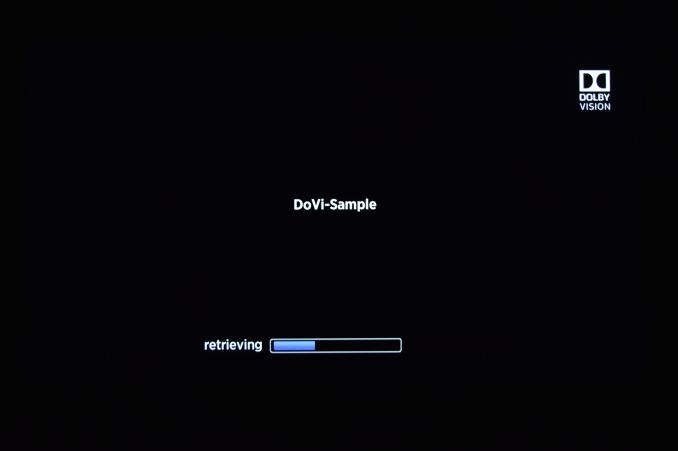

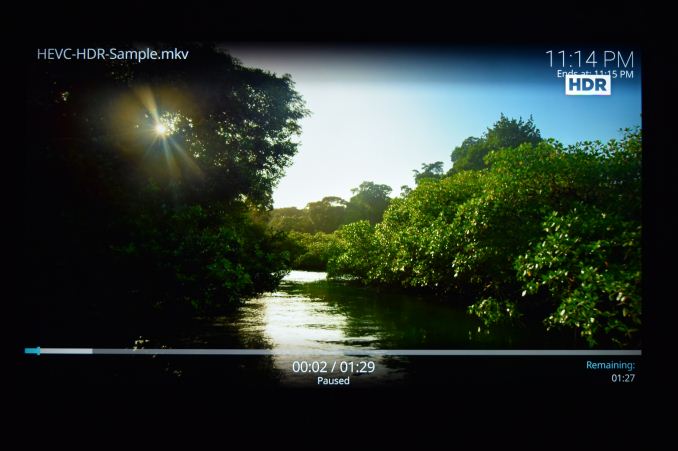
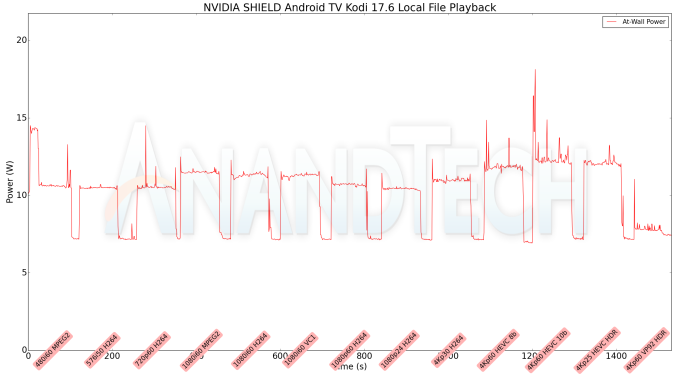
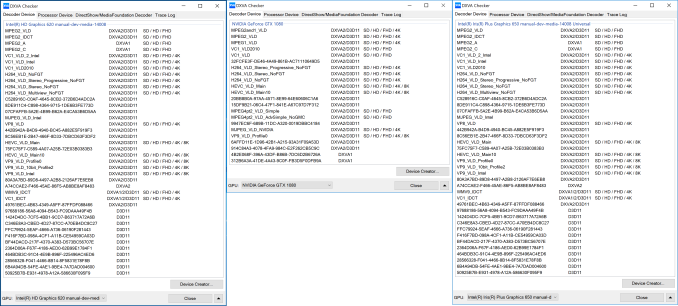
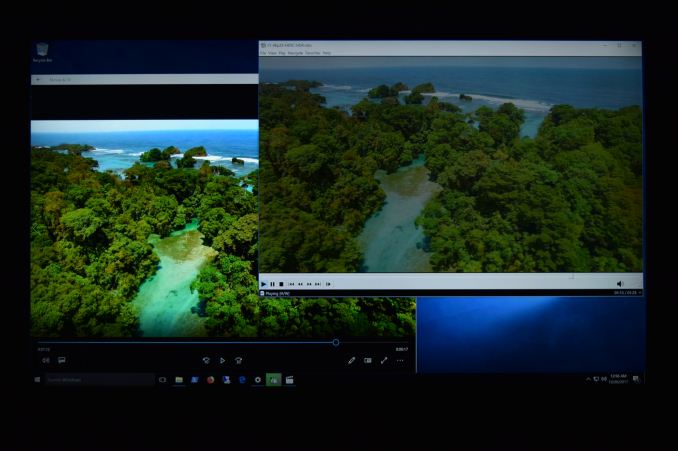
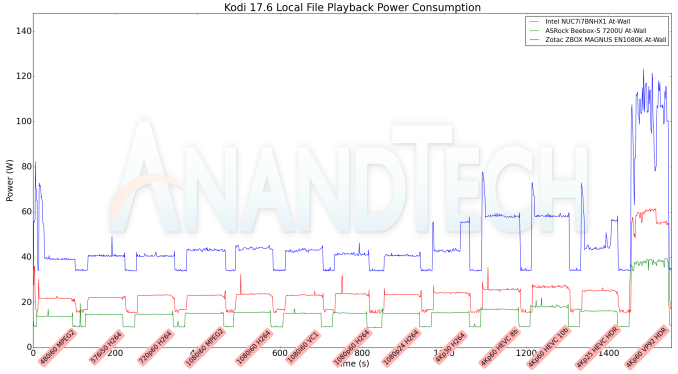










191 Comments
View All Comments
Lord of the Bored - Wednesday, December 27, 2017 - link
He didn't use a DVD player. He used a BluRay player. Completely different.And until streaming gets better bitrates it is an incomplete replacement from a purely technical standpoint. I mean, when regular BR supplies 50 megabits per second, UHD BR is a hundred mbps, and UHD Netflix is 25 mbps, there is OBVIOUSLY a quality sacrifice that has to be made(though the UHD situation is better than HD, where Netflix is a ridiculously compact FIVE mbps. I'll take a quarter the data over a tenth any day).
I mean, if you don't care about image and sound quality, you may as well watch VHS tapes off that old CRT you found in gramma's garage. I always thought home theater builds were about getting the best experience, not a really expensive mediocre experience.
CharonPDX - Wednesday, December 27, 2017 - link
"without worrying about it getting obsolete within the the next 3 to 5 years."JFC... A home theater system should last far longer than 3-5 years...
Bullwinkle-J-Moose - Thursday, December 28, 2017 - link
"JFC... A home theater system should last far longer than 3-5 years..."---------------------------------------------------------------------------------------------
Not with DRM!
A mans gotta know his limitations (Clint Eastwood)
pixelstuff - Wednesday, December 27, 2017 - link
I wish the manufacturers would create a decent set of components (AVR, Blu-ray, etc) that are not more than 8" deep so you can sit them below a wall mounted TV and they don't protrude way out into the room compared to the TV.Wiring would have to be on the sides with a standardized way to hide them, but I don't think extra width would be a big issue when placed under a large TV.
Dionysos1234 - Wednesday, December 27, 2017 - link
Recommending a Denon 999$ reciever is not only NON budget - It is also an extremely poor choice for reciever in that price range from an audio perspective. Guess HTPC is not an area where Anandtech have qualified people e.g. the amount of time devoted to showing poorly made graps on power consumption seems bizarre.Aikouka - Wednesday, December 27, 2017 - link
As for all the remarks about the receiver, my biggest piece of advice is to always buy last year's model UNLESS you absolutely need a feature only on the newest model. For example, I bought an X4300 for less than the article's X3400, and there really aren't any differences that would make me consider swapping.Aikouka - Wednesday, December 27, 2017 - link
As a quick note for the uninitiated, Denon's model numbers work where the thousands place is the model number and the hundreds place is the year. So, the 4300 that I mention above is the 4th-tier model (higher is better) from the third year. The 3400 is the third-tier model from the fourth year. So, mine is a higher model, but it's a year older. To see whether it's worth an upgrade, the AVS Forum's Denon Owner's Threads usually have comparisons to previous years (e.g. X#400 vs. X#300) that can help you decide whether the latest is worth it.r3loaded - Wednesday, December 27, 2017 - link
All I'm getting from this article is that HDR is a mess of confusing and incompatible standards and support, compounded by Hollywood's almost autistic fixation with ramming DRM down the throats of anyone wanting to watch 4K HDR content, and the very specific hardware requirements that it imposes on consumers.Also, why is it that there are tons of HDR TVs on the market but barely any HDR monitors? And conversely, why does no one make a 4K HDR TV smaller than 40 inches (say, 32 inches)? Not all of us are blessed with big houses that can fit the 55 inch TV mentioned in the review.
benedict - Wednesday, December 27, 2017 - link
Yep, sounds like too much trouble for what you're getting and you always risk some weird standard won't work on your expensive setup. Until they make this as simple as torrenting a movie the home theater market will remain a very tiny niche.CityBlue - Wednesday, December 27, 2017 - link
The BDA is expected to announce that the free to licence HDR10+ open standard is being added to the UHD BluRay standard in January at CES, and not the proprietary Dolby Vision. After that announcement I imagine DV will become a niche format. HDR10+ is simply what HDR10 should always have been.HDR10+ (compared with DV) also has a dramatically easier workflow as far as creative's are concerned, so combine that with the reduced licencing cost for manufacturers and there's very little reason to choose DV - the only winner there is Dolby.
It's not yet announced, but recommending DV over HDR10+ may not be such good advice.